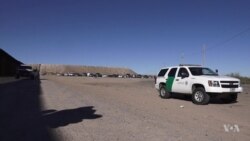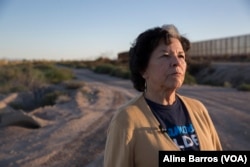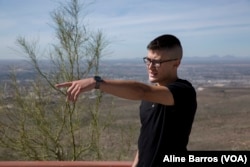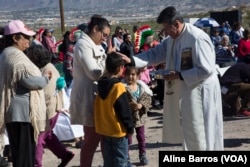Dr. Anna Perez is a tribal member of the Tigua Nation--one of three federally recognized Native American tribes in Texas and a resident of the federally-recognized tribal nation, Ysleta del Sur Pueblo, located in El Paso, Texas.
The view from the backyard of the adobe house she designed herself? Ciudad Juárez, Mexico.
“The beauty” of being so close to the border is to experience each other’s culture, said Perez, a registered Democrat, who volunteers with the party on a regular basis.
The interior of her house has been designed with no sharp edges and the wood beams overhead are carved with Native American symbols.
“The reality of living in a border town is that you have multicultural opportunities,” Perez said. “So I see it as being positive.”
El Paso is a possible destination for members of a migrant caravan coming up through Mexico from Central America. Though they remain hundreds of kilometers away from the U.S.-Mexico border, President Trump has stationed more than 7,000 active-duty troops along the U.S. Mexico border in preparation for their arrival.
On the eve of midterm elections,Texas residents have been drawn into a debate on what defines a crisis, and what values define them. Trump has claimed that the caravan is rife with criminals, gang members and disease carriers, and vowed to keep them out with the help of thousands of troops.
Walking the rusty metal border fence 10 minutes from her home, Perez says she doesn't know how the extra troops will affect the town. Residents are used to a military presence since Fort Bliss, a U.S. Army post has its headquarters in El Paso.
“But the presence of [extra] troops just puts a negative connotation on our nation, on our city, on our county,” she said, adding, “We’re not being invaded.”
From the Mexican side, one can hear a cacophony of sirens, shouting people, barking dogs and music.
Border town voices
“I just want a secure border. … Just make sure that they're doing everything they can to keep us safe,” Ian Valdez, a 22-year-old El Paso resident and registered Republican, told VOA.
El Paso in fact holds claim to the safest city in Texas and seventh overall in the U.S.
Though in a reliably Democratic county, local supporters of President Trump’s efforts to fortify the border and deter the caravan from touching U.S. soil make a case similar to immigration hardliners elsewhere in the country.
“If it’s 7,000 (in the migrant caravan), what prevents them from bringing on another 7,000, and another 7,000. We have to draw a line as to where and how we want to let people in the country,” Valdez said.
In fact, the caravan has been dwindling in size in recent days and is now estimated at less than half that number.
“I don’t feel unsafe because I live on the border,”said El Paso resident Aldo Coley who was playing soccer with friends on a Sunday morning. “But I think part of it is also because there’s a heightened sense of security that we’ve had specifically with border patrol and customs and immigration.” They work a “ton of hours,” he added.
Originally from Spain and now a citizen, Coley has lived in towns up and down the border, working for different manufacturing companies. He currently works for a company in Mexico, crossing the border everyday.
“They’re making it seem like people are coming with guns and stuff, and there’s no way they would come with guns, but we don’t know what we’re getting, right? So they should have respect for the country they’re coming into,” he said. “Just as everyday, when I go to work in Mexico, I have respect for their country.”
Regarding troops, he says “We’ve had the military on the border in the past…I don’t think it’s a big deal if it helps secure our borders.”
To others, the migrants are an opportunity to demonstrate El Paso hospitality.
“I feel like we're welcoming to others, and that’s what I like about El Paso,” 26-year-old El Paso resident Melania Garcia told VOA.
“They're preparing shelters; people are supporting with food, clothing, with coats, because the cold season is coming,” Luis Torres, a photojournalist documenting the migrant situation on the Mexican side, told VOA
Getting ready
“How you guys doin?” 83-year-old Othon Medina calls out to U.S. Customs and Border Patrol agents on the other side of the wall.
“Fine. Yourself?” One of the agents responds.
“We came to visit the wall!” Medina declares. To him, the president’s border actions are a smoke screen ahead of Tuesday’s midterm elections.
“Unless two countries get together; two neighbors try to get together and solve the problem… by insulting them and by putting another fence next to theirs and doing all this stuff, that’s not going to help it, not going to help anybody,” Medina says.
“The people in other parts of the United States don’t understand how we work together already with other countries,” says Perez still gazing through the fence at Ciudad Juárez.
She is working on a rooftop space for the house she designed so she can see the border - and beyond - from there.












